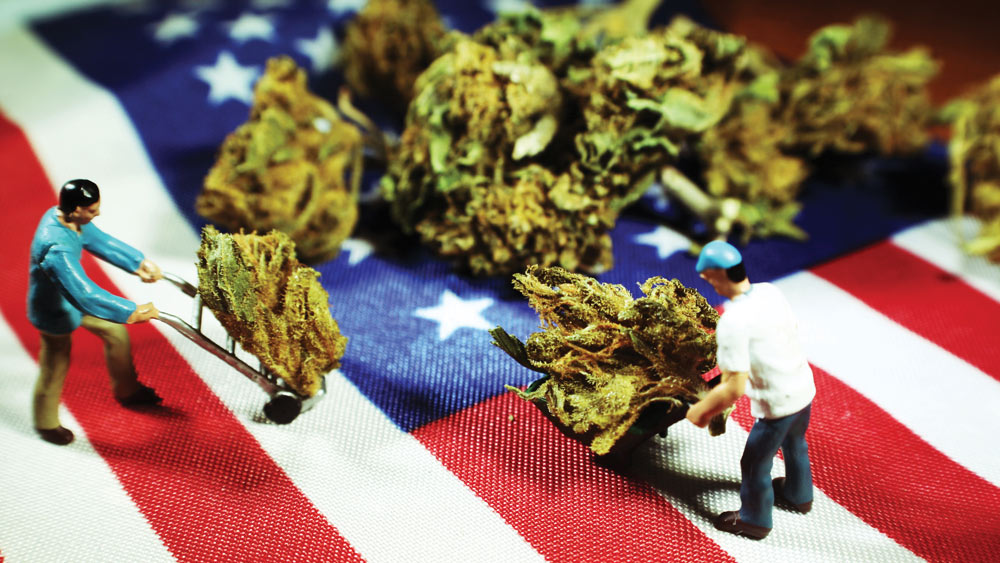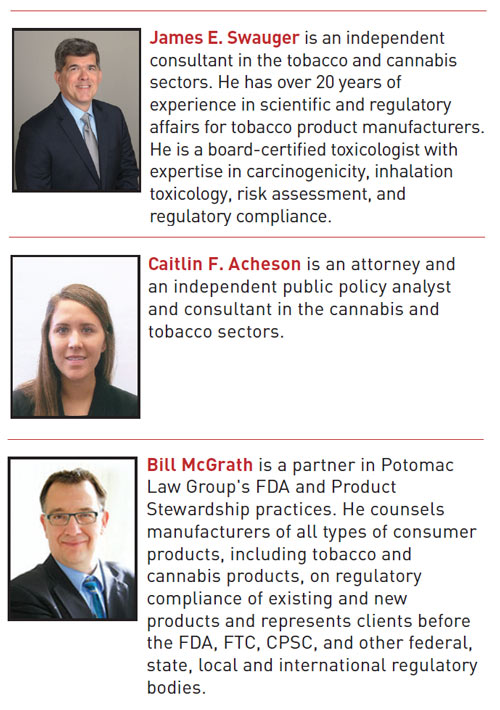
The Changing Face of Marijuana Regulation: Current Federal Status
by James E. Swauger, Caitlin F. Acheson, and William McGrath
Historically, under the Controlled Substances Act (CSA) the federal government has classified marijuana as a Schedule I narcotic. Substances in Schedule I have been determined by the U.S. Food and Drug Administration (FDA) to have no medical use and cannot lawfully be prescribed or sold to the public. Intermittent legislative attempts to repeal this classification and to permit marijuana for medical or recreational use have failed.
 Schedule I classification was confirmed by the Drug Enforcement Administration (DEA) in August 2016. In response to a 2009 citizen petition requesting that it initiate proceedings to reschedule marijuana, DEA indicated its intent to keep marijuana illegal for any purpose.1
Schedule I classification was confirmed by the Drug Enforcement Administration (DEA) in August 2016. In response to a 2009 citizen petition requesting that it initiate proceedings to reschedule marijuana, DEA indicated its intent to keep marijuana illegal for any purpose.1
In making this determination, DEA relied on a requested Health and Human Services scientific and medical evaluation and scheduling recommendation. The recommendation concluded that marijuana has no “currently accepted medical use” because “the drug’s chemistry is not known and reproducible; there are no adequate safety studies; there are no adequate and well-controlled studies proving efficacy; the drug is not accepted by qualified experts; and the scientific evidence is not widely available.” Although DEA noted that marijuana has a high potential for abuse and can result in psychological dependence, it did not conclude that marijuana is a gateway drug. DEA concluded that there was little evidence to support the frequently cited concern that initiation of marijuana use leads to an abuse disorder with other illicit substances.2
While marijuana remains illegal on the federal level, the U.S. government has taken a somewhat hands-off approach with respect to state laws legalizing marijuana use. In 2013, the Department of Justice issued a guidance outlining certain criteria that, if followed, would allow states to implement their own medical- or recreational-use laws without federal interference.3 However, current Attorney General Jeff Sessions has repeatedly made clear his disdain for legalized marijuana, potentially placing in doubt continued federal acquiescence to state marijuana laws.4 Therefore, absent congressional action, the sale, distribution, or manufacture of marijuana will likely remain a federal crime for the foreseeable future.
Current State Status
Over the last two decades, the classification of marijuana as a Schedule I narcotic has not prevented individual states from legalizing the use of marijuana for medical purposes and, in some cases, legalizing the use of marijuana for recreational uses.5 As of the November 2016 elections, 25 states plus the District of Columbia had medical marijuana provisions on their books and eight states plus the District of Columbia had recreational marijuana provisions on their books.
Federal-State Intersection
The cultivation, distribution, sale, and use of marijuana remain a federal crime in every state, including those that have enacted medical or recreational marijuana laws. Even in those states that have made marijuana possession by certain persons for certain purposes legal, the federal government retains the power to enforce federal drug laws against those very persons. Compliance with a state medical marijuana provision is not a defense in a federal prosecution under the CSA.6
States may elect not to enforce their own criminal laws against persons who provide or use marijuana for medical or, in some cases, recreational purposes. States may also selectively elect to ignore federal law with which they disagree. However, they cannot legalize marijuana outright.
State Recreational Use Regulatory History
While the evolution of regulatory frameworks addressing use of medicinal marijuana has not been completely smooth, it is the approval and regulation of recreational marijuana that has generated the most controversy and uncertainty from a social, business, regulatory, and enforcement perspective.
In 2012, 2013, and 2014, respectively, Colorado, Washington, and Oregon passed state laws legalizing the recreational use of marijuana. In each state, stakeholders with diverse viewpoints developed regulations intended to operationalize these new laws. Generally, these regulations reflected the specific issues and concerns of the stakeholders involved in drafting the regulations. In each state, regulators were challenged to create novel regulation. In a fashion eerily familiar to regulatory activity focused on the Electronic Nicotine Delivery System (ENDS) market, regulators were compelled to develop formal definitions for terms reflecting evolving consumer language used to describe such products. To date, the existing regulations have primarily focused on the mechanics of developing a licensure process and basic compliance required to manage oversight of the sector.
In the absence of federal regulation addressing the subject, regulation of the recreational marijuana market by individual states has created a morass. Although there is some similarity between the approaches taken in each of these early adopter states, at the detail level, they differ substantively. The experience and skillsets of the organizations tasked with creating cannabis regulation at the state level are diverse. For example, in Colorado, Washington, and Oregon, recreational use of marijuana is regulated by the Colorado Department of Revenue (CDR), The Washington State Liquor and Cannabis Board (WSLCB), and the Oregon Liquor Control Commission (OLCC), respectively.
To date, there is little consistency from one state to another in the approach taken to regulate the sector. For example, residency requirements in Colorado, Washington, and Oregon associated with licensing rules range from none to two years.7 While this sounds like it would be straightforward—it is not. To the extent that residency matters, who is required to be a resident? Is it the license holder, the owner of the business, or an individual or entity that invests in the business? The answer is, it depends.
Regulatory stability has also proven elusive. Regulations in early adopter states have frequently evolved and continue to present a complicated maze that must be navigated by any potential business owner. For example, Oregon residency requirements were a source of confusion and ongoing discussion from the beginning, making business planning efforts somewhat futile.8 In 2016, the issue was finally clarified and the residency requirements were resolved, which opened the door for potential non-resident entrepreneurs interested in the Oregon market. Approximately a year after the initiation of recreational sales in Oregon, OLCC, taking a page from state efforts to regulate the ENDS sector, banned the use of 14 brand names based on the presumption they would be attractive to sensitive populations.9 While the utilization of such brand names may be subject to criticism, a regulatory environment characterized by poorly defined decision-making processes and the development of arbitrary standards is a recipe for chaos in the market place. Given the ongoing evolution of the regulatory environment at the state level, it is difficult for stakeholders to develop a clear understanding of the operative rules and attempt to operate a business.
Continuing Evolution of Marijuana Regulation
In the 2016 elections, the number of states placing medicinal and recreational marijuana laws on their books expanded significantly. We are about to see the development of a substantial number of new regulatory schemes across the country. This circumstance creates a meaningful opportunity to bring consistency to these regulations and address potential shortcomings.
As noted, existing state-specific regulations vary widely, reflect local concerns and prejudices, and change rapidly. Further, existing regulation appears to fail to adequately address product quality and other potential health-related concerns. Manufacturing practices vary significantly and, to date, sector-specific good manufacturing practices have yet to be developed and implemented.
Focus on the product and product quality has been generally concentrated on product strength and consistency. These measures are critical to product quality and the ability of potential consumers to make an informed purchase. However, to date, limited attention has been paid in these regulations to several potential product-related public health issues. For example, the existing regulations do not address potential health consequences associated with the use of either combustible or noncombustible forms of marijuana. Further, product quality issues related to agrochemical use and issues such as bacterial and fungal contamination have been addressed inconsistently, at best, and remain problematic. Reports of products contaminated with bacteria, fungi, and banned pesticides are becoming common.10 Existing regulation focuses to varying degrees on product-related contamination with bacteria, fungi, and/or agrochemical use. However, the approaches taken to address these issues and the agrochemicals approved for use vary by state.
Existing state regulation does not appear to consider the underlying potential risk associated with the use of these products or the potential impact of product composition and processing techniques on the potential toxicity of such products. The lack of focus is exacerbated by the fact that very little data are available that characterize the chemistry and toxicity associated with these products as a class, let alone on a product-specific basis.
Few studies have addressed the potential chronic health effects that may be associated with exposure to marijuana smoke, and none appear to have been reported addressing the potential chronic health effects of other forms of marijuana products that have entered the market place more recently. Given the rapid rate at which this market is growing, the absence of studies in animal models addressing the potential long-term effects of exposure to these products is particularly troubling. The absence of such data makes it far too easy for stakeholders to lose sight of the uncertain outcome and the potential risks associated with long-term exposure to marijuana smoke or other noncombustible forms of marijuana.
Limited examinations of marijuana smoke, including for cannabinoid content and tar generation, have been reported in the existing literature.11 The data that is available suggest that in many respects marijuana smoke is similar to cigarette smoke. Limited data has been published comparing the composition of marijuana smoke to tobacco smoke utilizing International Organization for Standardization (ISO) and Canadian intense puffing conditions.12 The results of these studies demonstrate qualitative and quantitative similarities between marijuana and tobacco smoke that represent a potential source of concern that should be addressed through appropriate regulation. For example, these studies suggest that marijuana smoke contains significantly higher levels of ammonia, hydrogen cyanide, nitric oxide (NO), nitrogen oxides (NOx), and some aromatic amines than is observed in tobacco smoke produced using similar puffing conditions.
Considerable data are available that address the potential differences in chemistry or toxicity that may be associated with different tobacco types. These reported observations apparently serve as the basis for FDA’s position that blend changes in a tobacco product (other than maintenance changes) are a substantive change sufficient to produce a “new” tobacco product under the Tobacco Control Act.13 To date, little has been reported regarding the potential impact of marijuana type or variety selection or blending on chemistry, toxicity, or potential health consequences. In short, the impact of the type or blend of marijuana used in a related product is generally unknown. This is particularly troubling, given the fact that the market appears to be moving towards products comprised of highly specific varieties of marijuana selected for their unique properties and marketed in ways that place emphasis on the marijuana strain utilized (e.g., Maui Wowie!). In addition, there is very little known about the potential impact of non-marijuana ingredients added to marijuana blends or marijuana processing techniques on either the chemistry of marijuana smoke or its potential toxicity.
In addition, the non-combustible segment of this market is expanding at an incredibly rapid rate. There is little or no published research addressing the potential long-term health effects of non-combustible forms of marijuana currently in the market. Consistent with the absence of information regarding combustion-based marijuana products, little is known about the potential impact of added ingredients or processing techniques on the toxicity of these forms of marijuana.
It is apparent that there are numerous product-related issues presented by the commercial distribution of these products that have not been adequately addressed by existing regulation.
Discussion
The November 2016 elections continued the rapid expansion of the number of states with medicinal and recreational use marijuana laws. The development of additional regulation in various states offers an opportunity to bring additional consistency to state-level cannabis regulation and address potential shortcomings associated with existing regulation.
Recent data from the Colorado market has suggested that six percent of adults reported using marijuana every day or nearly every day.14 Fifty percent of 18-25-year-old self-identified cannabis users reported daily or near daily use of marijuana.15 Given the expansion of these markets and the rapid evolution of both the combustible and non-combustible segments of this sector, further consideration of the regulatory oversight of these products is warranted.
These questions may best be addressed by a uniform, coordinated policy rather than dozens of separate regulatory schemes created by individual states. Absent congressional action, however, this is unlikely to occur. And, should Congress choose to legalize marijuana in the future, it would have to determine which federal agency should be charged with regulating marijuana. Many would argue that the most likely candidate is FDA. However, FDA oversight is notoriously cumbersome and expensive to both industry and consumers. The time and expense required to get a new medical product approved has long been a subject of complaint. And, there are significant questions as to whether and how the nascent vapor industry will survive FDA’s excursion into regulating another recreational drug—nicotine. Any legislation creating a national marijuana policy must choose its regulator carefully to ensure appropriate public health oversight without creating a regulatory scheme that will push innovative players out of the market.
In the near to mid-term, industry members must individually and collectively take steps to create the foundation for a future national regulatory scheme.
Industry should work to develop and implement broadly focused product stewardship programs that address cultivation and manufacturing best practices, labeling and advertising ground rules, dosage instructions and warnings, and marketing and packaging protections to avoid exposure to youth. It seems essential that companies develop an understanding of the potential health risks associated with the long-term use of these products. Further, companies should consider appropriate evaluation strategies to facilitate the development of an understanding of the potential impact of the addition of ingredients to these products and/or of specific processing techniques used to manufacture them.
By coming together and taking these steps, companies can create a set of industry standards that will ensure the safety and quality of product, form the centerpiece for company risk-management efforts and potentially set the framework for any future regulatory scheme. Doing so would enhance public health, demonstrate industry responsibility to consumers, and help the industry continue to develop the expertise necessary as this product sector continues to expand.
- Denal of Petition To Initiate Proceedings To Reschedule Marijuana, 81 Fed. Reg. 156 (August 12, 2016) (amending 21 C.F.R. Chapter II).
- Id.
- Department of Justice, “Guidance Regarding Marijuana Enforcement” (August 29. 2013) https://www.justice.gov/iso/opa/resources/3052013829132756857467.pdf.
- Tom Angell, “Jeff Sessions Slams Marijuana Legalization (Again),” Forbes Magazine (Sept. 20, 2017) https://www.forbes.com/sites/tomangell/2017/09/20/jeff-sessions-slams-marijuana-legalization-again/#2de5bd4027d1.
- Compassionate Use Act of 1996, H.S.C. 11362.5.
- US v. Oakland Cannabis Buyers’ Cooperative, 532 U.S. 483 (2001).
- Colo. S.B. 16-040 (2016); Marijuana Licenses, Application Process, Requirements, and Reporting, WAC 314-55 (2017); Or. H.B. 3400 (2014).
- Or. H.B. 3400 (2014); Or. H.B. 3400 (Amended 2016).
- Clarification on Marijuana Products Attractiveness to Children and Strain Names, OLCC, September 23, 2016, www.oregon.gov/olcc/marijuana/Documents/Packaging_Labeling/Strain_Name_Attractiveness_Children.pdf.
- Baca, Ricardo. “Are You Consuming Pesticides or Other Contaminants in Your Cannabis? Colorado Recall List (Updated 7/27/17).” The Cannabist, 4 Dec. 2015, www.thecannabist.co/2015/12/04/pesticide-pot-recall-list-marijuana/44711/; Handwerk, Brian. “Modern Marijuana Is Often Laced With Heavy Metals and Fungus.” Smithsonian Magazine, 23 Mar. 2015, www.smithsonianmag.com/science-nature/modern-marijuana-more-potent-often-laced-heavy-metals-and-fungus-180954696/; Mckernan, Kevin, et al. “Metagenomic Analysis of Medicinal Cannabis Samples; Pathogenic Bacteria, Toxigenic Fungi, and Beneficial Microbes Grow in Culture-Based Yeast and Mold Tests.” F1000Research, vol. 5, 7 Oct. 2016, doi:10.12688/f1000research.9662.1; OLCC Issues Marijuana Product Recall, OLCC, March 18, 2017, www.oregon.gov/olcc/docs/news/news_releases/2017/nr_03_18_17_Emerald_Wave_recall.pdf; “Steep Hill Launches New High Detection Cannabis Pesticide Testing in California.” 19 Oct. 2016, steephill.com/pdf/uploads/pressrelease/230e778e18d25bf4740957e90b4d7de3.pdf; Thompson, GR, et al. “A Microbiome Assessment of Medical Marijuana.” Clinical Microbiology and Infection, vol. 23, no. 4, Apr. 2017, pp. 269–270.
- Fehr, K. O’Brien, and H. Kalant. “Analysis of Cannabis Smoke Obtained under Different Combustion Conditions.” Canadian Journal of Physiology and Pharmacology, vol. 50, no. 8, 1972.
- Moir, D., et al. “A Comparison of Mainstream and Sidestream Marijuana and Tobacco Cigarette Smoke Produced Under Two Machine Smoking Conditions.” Chem. Res. Toxicol, vol 21, 2008; Rickert, W.S., et al. “A Comparison of Tar, Carbon Monoxide and pH Levels in Smoke From Marihuana and Tobacco Cigarettes.” Canadian Journal of Public Health, vol. 73, no. 6, 1982.
- Family Smoking Prevention and Tobacco Control Act, Pub. L. No. 111-31.
- Staff, CBT. “Fast Stats: Behavioral Risk Factor Surveillance System (BRFSS)/Monitoring Health Concerns Related to Marijuana in Colorado.” Cannabis Business Times, 2016, magazine.cannabisbusinesstimes.com/article/march-2017/fast-stats-march-2017.aspx.
- Id.
Update Magazine
September/October 2017









